Right bundle branch block: Difference between revisions
| Line 76: | Line 76: | ||
The [[prevalence]] of RBBB increases with age. | The [[prevalence]] of RBBB increases with age. | ||
==Natural | ==Natural History, Complications and Prognosis== | ||
In general, the natural history of right bundle branch block benign. There are three scenarios in which right bundle branch block can be associated with poor prognosis: | In general, the natural history of right bundle branch block benign. There are three scenarios in which right bundle branch block can be associated with poor prognosis: | ||
Revision as of 17:17, 17 October 2012
| Right bundle branch block | |
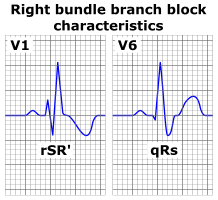 | |
|---|---|
| ECG characteristics of a typical RBBB showing wide QRS complexes with a terminal R wave in lead V1 and slurred S wave in lead V6. | |
| ICD-10 | I45.1 |
| DiseasesDB | 11620 |
Editor-In-Chief: C. Michael Gibson, M.S., M.D. [1] Associate Editor-In-Chief: Cafer Zorkun, M.D., Ph.D. [2]
Synonyms and keywords: RBBB
Overview
Right bundle branch block (RBBB) results from a defect in the heart's electrical conduction system. There is a delay in failure of transmission of electrical impulses down the right bundle of the heart. As a result, the right ventricle depolarizes by an alternate mechanism. This is by means of cell-to-cell conduction. These cell to cell conduction impulses spread more slowly than usual from the interventricular septum to the left ventricle and to the right ventricle. This delay in conduction results in the characteristic ECG pattern which is a wide and notched QRS. Although conduction down the right bundle is delayed, conduction down the left bundle is normal. As result, the interventricular septum and left ventricle depolarize in the normal fashion.
Pathophysiology
Three types of RBBB have been identified based upon electrophysiologic studies.
In each of the three types of RBBB, the surface ECG pattern remains the same.
1. Proximal, or central, RBBB: This type of conduction defect occurs when the conduction block is located just distal to the bundle of His in the superior aspect of the right bundle branch. This type of block occurs when the proximal bundle is injured during surgery for an inlet or membranous ventricular septal defect (VSD).
2. Interruption between the proximal and distal aspects of the right bundle branch: This type of right bundle branch block occurs when the impulse is interrupted between the proximal and distal aspects of the right bundle branch. This type of bright bundle branch block is most commonly observed after surgical division of the moderator band.
3. Distal RBBB: This form is observed when distal ramifications of the right bundle are disrupted during right ventriculotomy or resection of muscle bundles in the right ventricular outflow tract.
Genetics
There can be familial cases of right bundle branch block such as that observed in 4 Lebanese families and the abnormality was mapped to chromosome 19.
There is a subset of patients with Brugada syndrome who have mutations in SCN5A, the gene encoding for the voltage-gated cardiac sodium channel.
Associated syndromes
- Myotonic dystrophy Other ECG findings include first-degree AV block, left anterior fascicular block, and intraventricular conduction delay. Patients may have arrhythmias and/or Stokes-Adams attacks.
- Brugada syndrome: This syndrome is due to a channelopathy mediated by the SCN5A gene. It is important to note that the RBBB pattern seen in patients with this syndrome is not actually RBBB but is instead due to a repolarization abnormality. In this syndrome, the ECG shows ST-segment elevation in leads V1-V3. Cocaine consumption and / or the use of the antiarrhythmic propafenone may unmask the ECG findings of Brugada syndrome.
Causes
- Surgery for correction of congenital heart disease is the most common cause of RBBB among children any United States. This includes surgery for repair of an isolated VSD or another congenital heart disease that includes a VSD (eg, double-chambered right ventricle, AV canal defect, or tetralogy of Fallot). The incidence of RBBB varies and ranges from 25-81% after repair of a VSD to 60-100% after repair of tetralogy of Fallot. The risk of RBBB after surgery varies depending upon the proximity of the VSD to the His-Purkinje system.
- Blunt trauma
- Polymyositis
- Premature atrial contractions or supraventricular tachycardia may cause a transient form up right bundle branch block. This occurs when a premature impulse is conducted from the AV node to the His bundle while the right bundle branch remains in its refractory period, but the left bundle is not. As a result, conduction down the right bundle branch is delayed or blocked.
- Prenatal exposure to each one HIV type 1 may cause right anterior hemiblock.
- Familial
Differential Diagnosis
- Acute pulmonary embolism
- Atrial septal defect
- Cardiomyopathy
- Cor Pulmonale
- Coronary Heart Disease
- Lenegre's Disease
- Lev's Disease
- Myocardial Infarction
- Myocarditis
Epidemiology and Demographics
Age
The prevalence of RBBB increases with age.
Natural History, Complications and Prognosis
In general, the natural history of right bundle branch block benign. There are three scenarios in which right bundle branch block can be associated with poor prognosis:
- Brugada syndrome: if right bundle branch block is present, then sudden death may occur.
- Kearns Sayre syndrome: again, if right bundle branch block is present than sudden death may occur.
- Tetralogy of Fallot: if right bundle branch block is present with a markedly prolonged QRS (< 180 ms), then the patient may be at risk for ventricular arrhythmias and sudden death.
If right bundle branch block is due to surgery then there are generally no acute hemodynamic consequences. The subsequent courses also quite benign. An exception is if there is substantial injury to the His-Purkinje system in which case left anterior hemiblock or first-degree AV block may be present.
There are familial cases of right bundle branch block, which are benign.
Diagnosis
Physical Examination
Heart
Right bundle branch block is associated with a persistently split second heart sound with normal respiratory variation in the splitting interval.
Laboratory Findings
If there is a history of blunt trauma or any symptoms to suggest polymyositis then troponin, creatine kinase (CK) and an echocardiogram should be obtained.
Electrocardiogram
- The heart rhythm must be supraventricular in origin
- The QRS axis can be either normal, or right or left axis deviation may be present.
- The QRS duration must be = or > 120 ms
- For complete RBBB, the patient's age must be taken into account to determine if the duration of the QRS complex is prolonged for the patient's age.
- Maximum QRS durations are 0.07 s for newborns <6 days, 0.08 s for patients aged 1 week to 7 years, and 0.09 s for patients aged 7-15 years.
- For complete RBBB, the patient's age must be taken into account to determine if the duration of the QRS complex is prolonged for the patient's age.
- There should be a terminal R wave in lead V1-V3R (e.g., R, rR', rsR', rSR' or qR')
- This pattern is present because the initial R wave represents septal activation, the S wave represents left ventricular activation, and the R' represents activation of the right ventricle from the septum and left ventricle.
- There should be a slurred S wave in leads I and V6. This represent left ventricular activation.
- Because transmission of the electrical impulse through the left bundle is normal, this results in normal depolarization of the septum and the left ventricle. As a result, there is an initial R wave in lead I and V1 and the Q wave in V6.
The T wave should be deflected opposite the terminal deflection of the QRS complex. This is known as appropriate T wave discordance with bundle branch block. A concordant T wave may suggest ischemia or myocardial infarction.
Below is an electrocardiogram showing the main characteristics of right bundle branch block on lead V1.
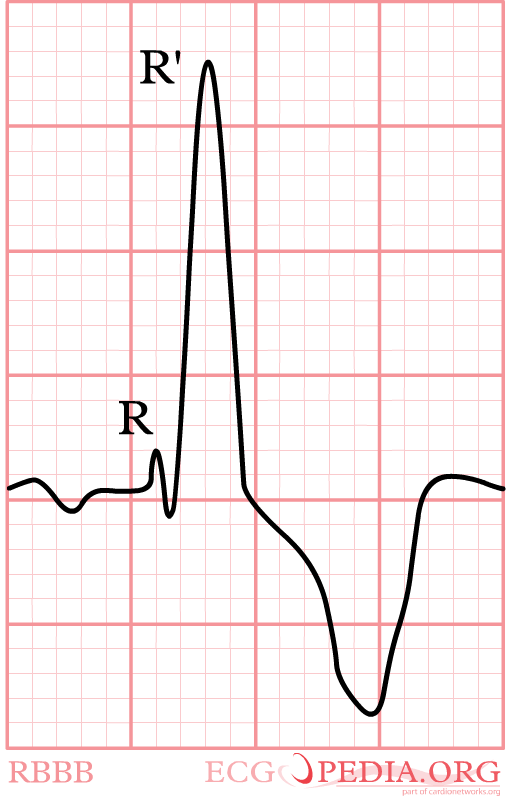
The rhythm is sinus. The QRS is wide (>120ms.) and the axis is markedly negative. There are small R waves in the inferior leads. The recording shows a right bundle branch block and a left anterior fasicular block.
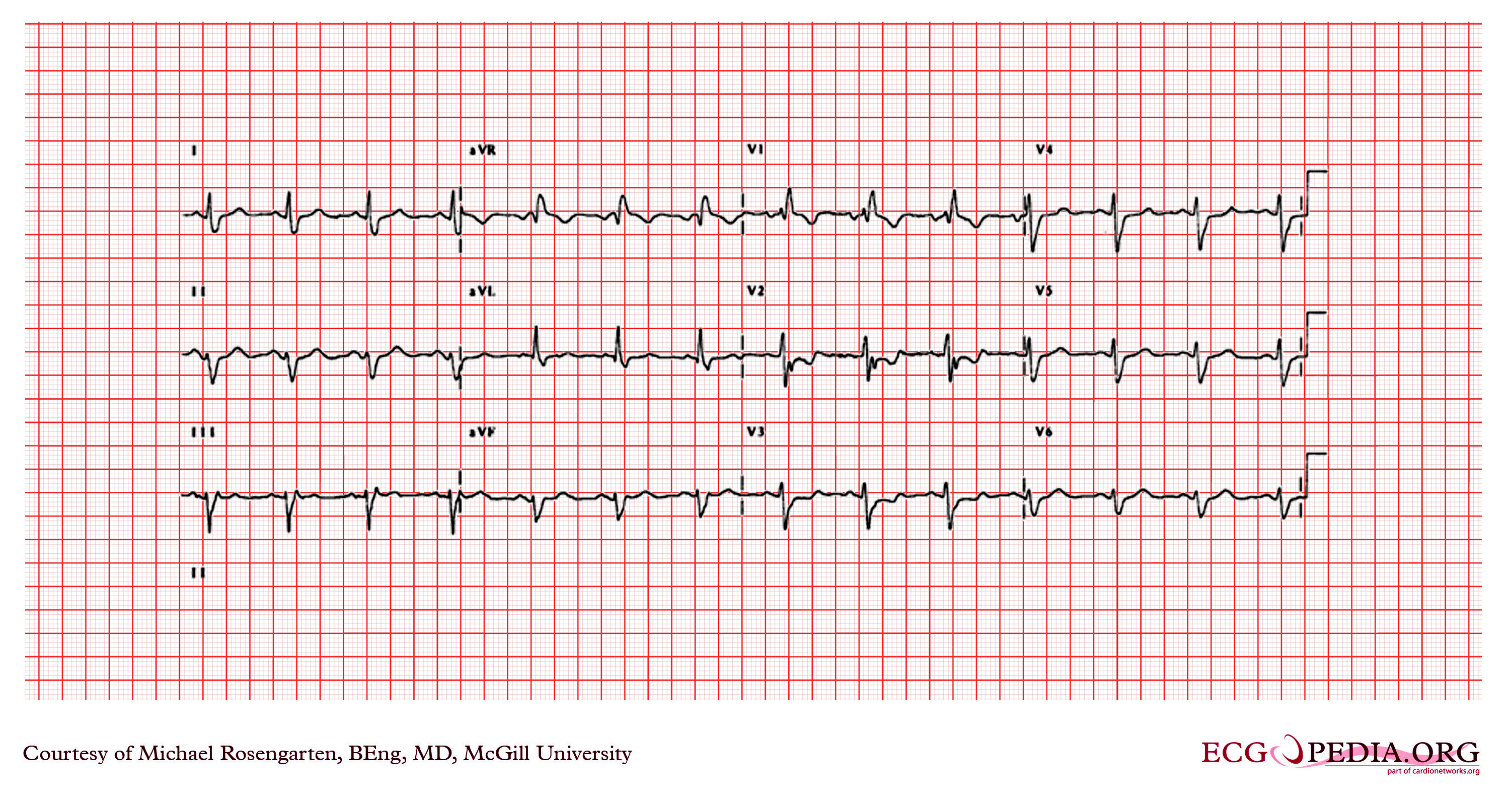
EKG Examples
EKG below is from an elderly woman who had previously undergone surgery for recurrent ventricular tachycardia. She was being treated with Tambacor and metoprolol. The cardiogram shows sinus rhythm with a wide QRS of 159ms consistent with a RBBB and a rightward axis suggesting right posterior hemi-block. The PR interval is slightly prolonged at 2121ms. The poor R wave progression seen best in lead V2 suggests previous anterior wall MI.
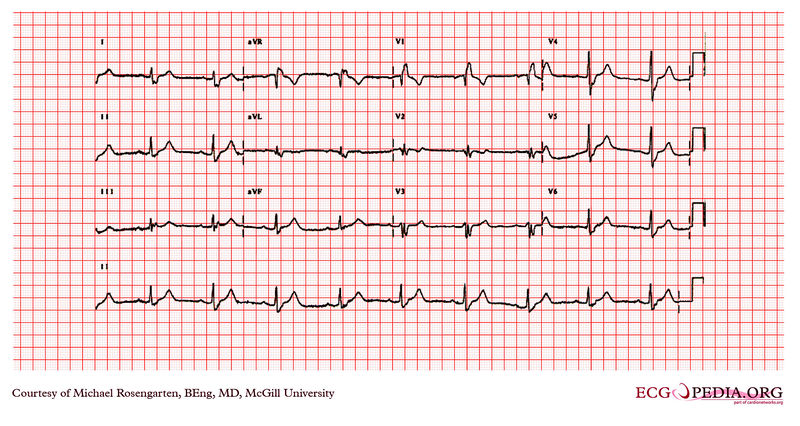
EKG below is a recording from an older man in the surgical intensive care unit. He was recovering from a motor vehicle accident where he sustained a chest injury from his seat belt. The rhythm is sinus rhythm with a prolonged p wave duration in lead III( >140ms) and a pronounced terminal negativity in V1 suggestive of left atrial abnormality. The QRS is wide with a duration of 137ms and a superior and right ward axis. There is an RSR in V1 and the S wave is greater than the R in V6. This is an unusual pattern for aberrance and is more in keeping with ventricular ectopy. In this case, this appears to be a right bundle branch block with a possible left posterior hemi-block.
Of note, in spite of this conduction disturbance the patient was able to sustain reentrant supraventricular tachycaridas requiring intravenous adenosine for termination.
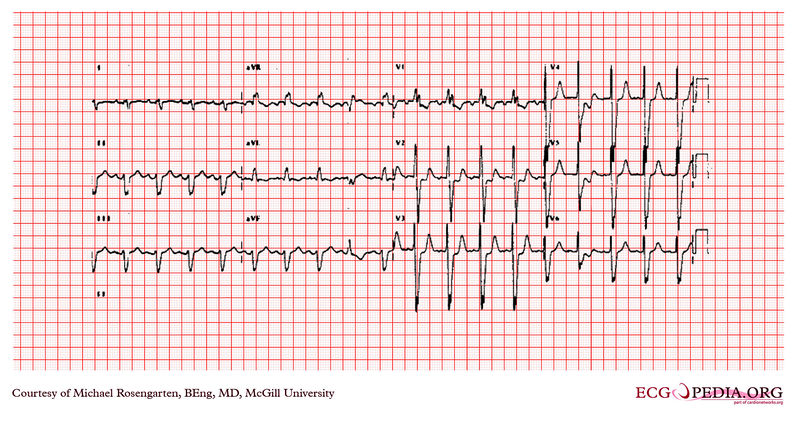
Below is an electrocardiogram showing right bundle branch block.
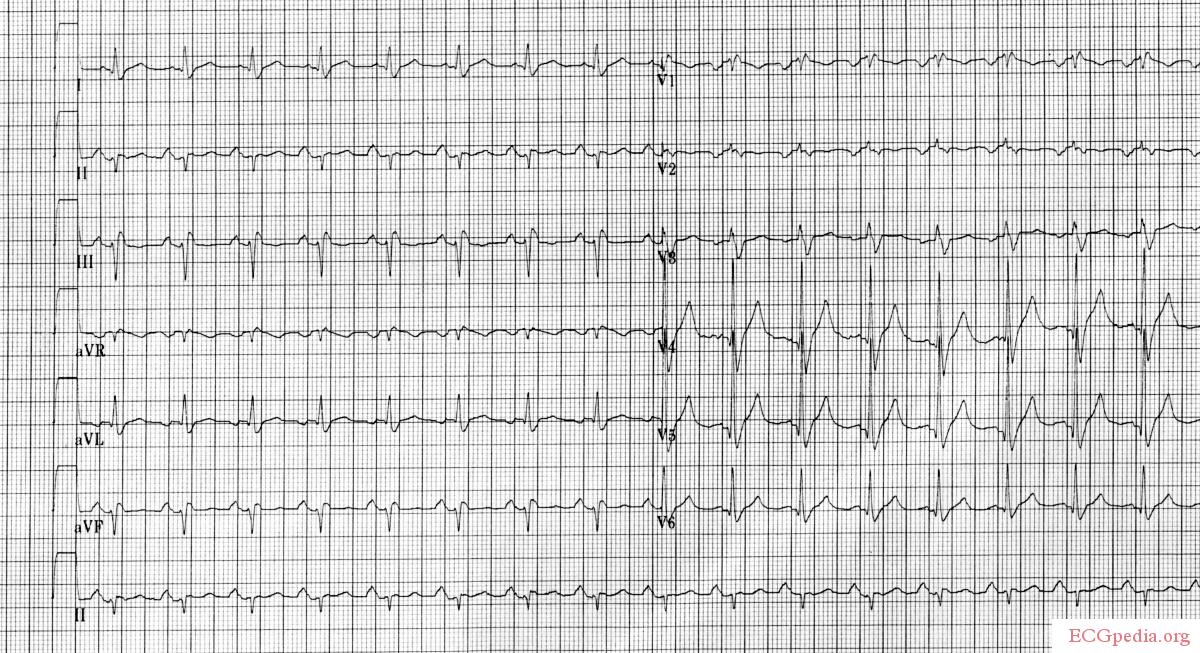
Below is an electrocardiogram showing right bundle branch block.
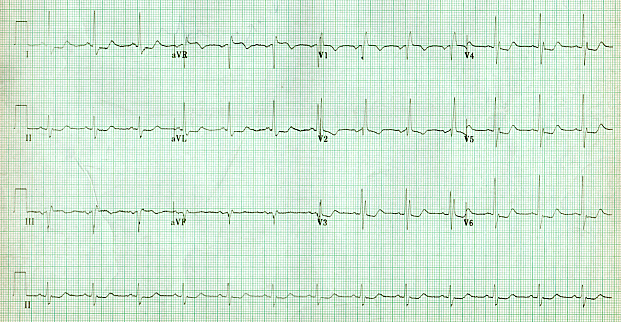
Below is an electrocardiogram showing right bundle branch block.
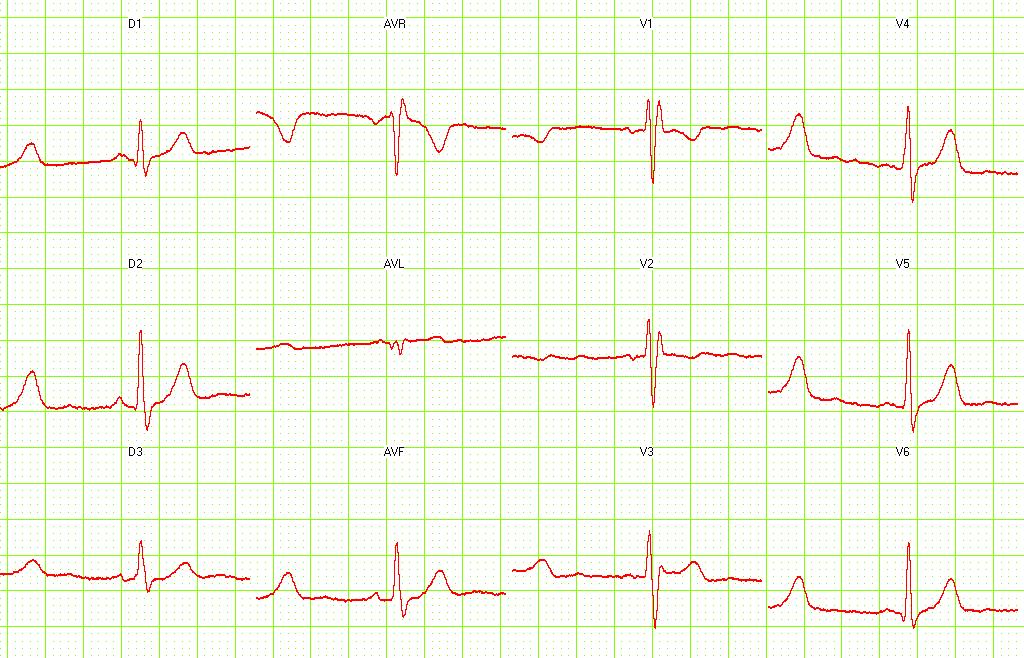
Below is an electrocardiogram showing right bundle branch block.
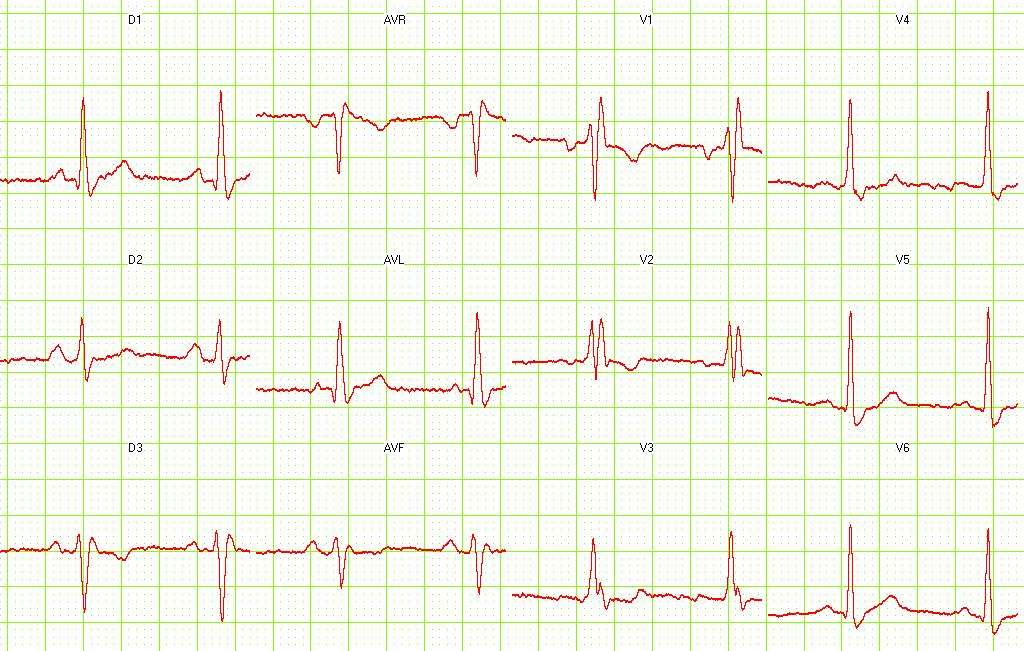
Below is an electrocardiogram showing right bundle branch block.
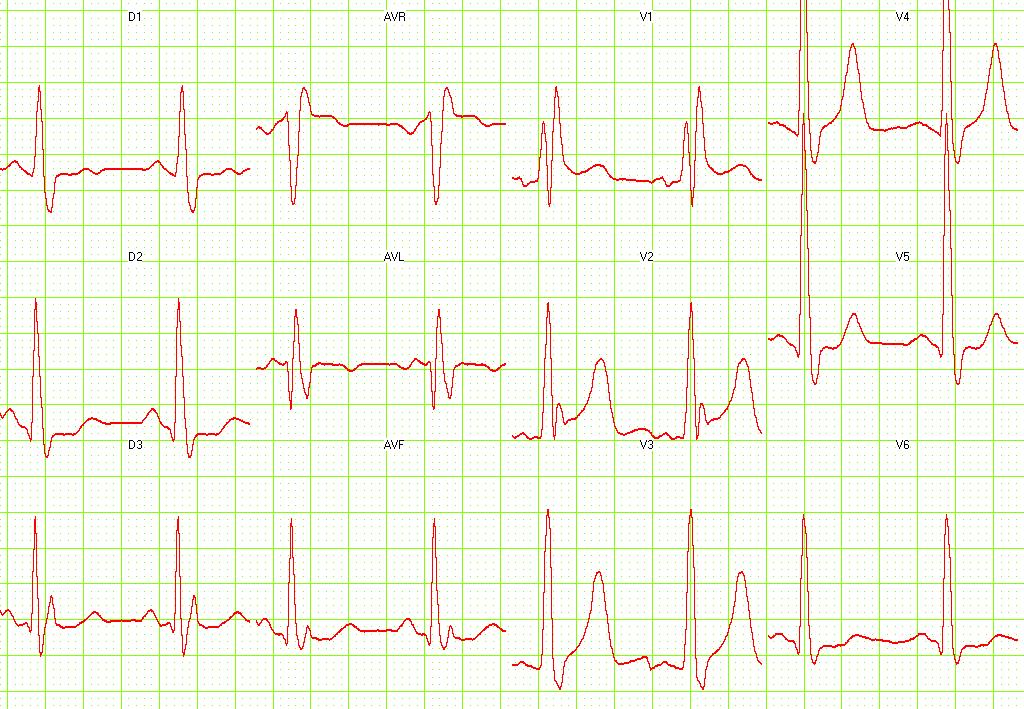
Below is an electrocardiogram showing right bundle branch block.
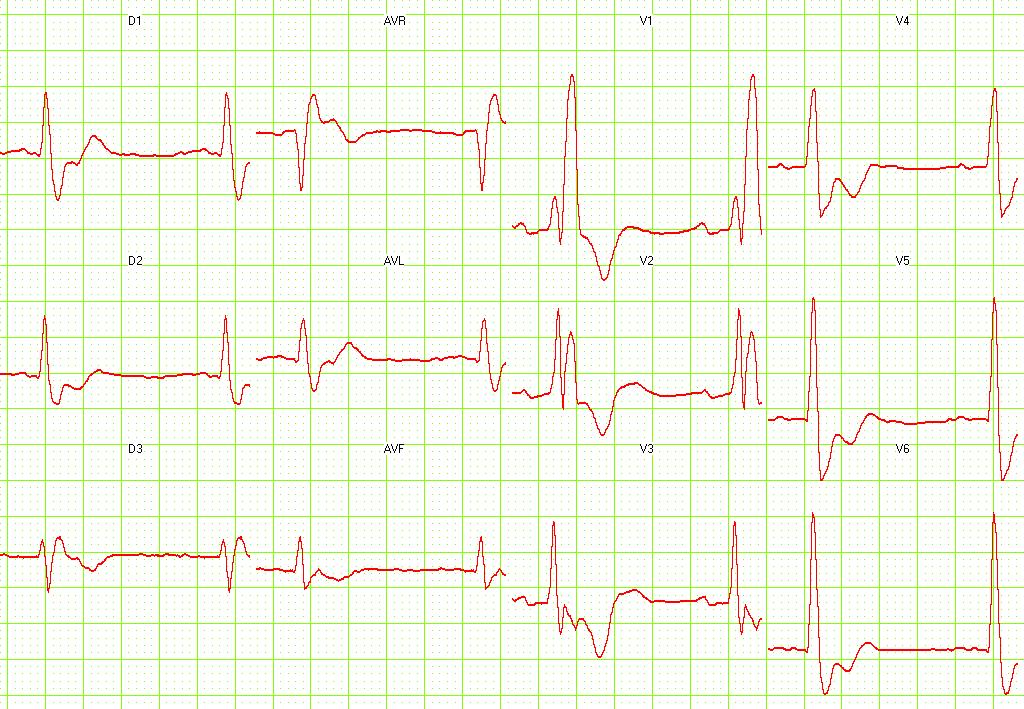
Below is an electrocardiogram showing right bundle branch block with first degree AV block.
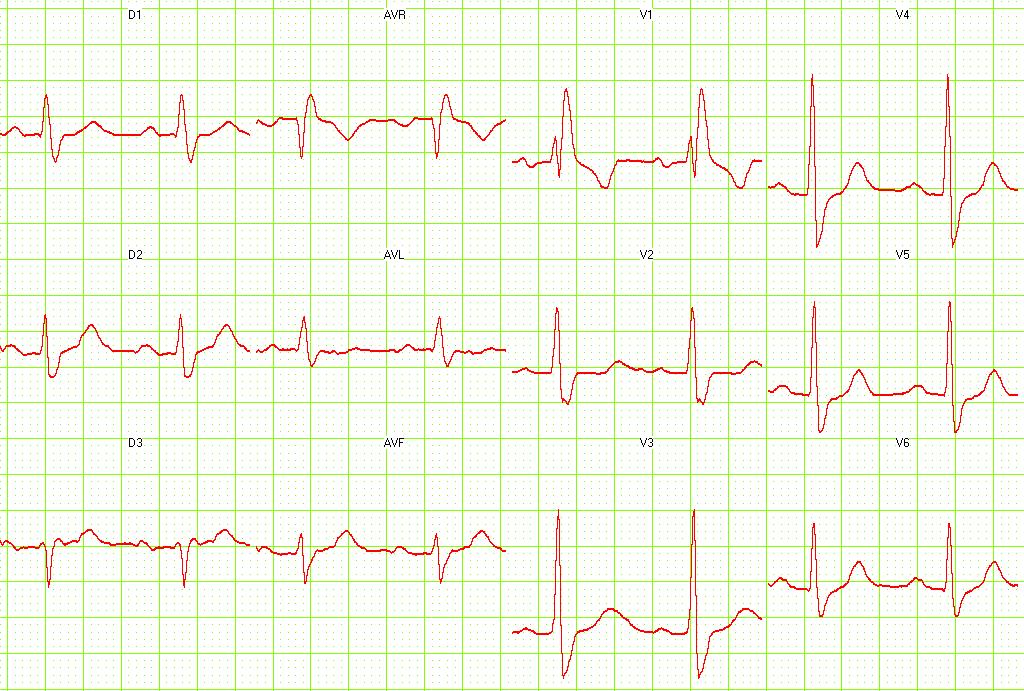
Below is an electrocardiogram showing right bundle branch block with right atrial hypertrophy.
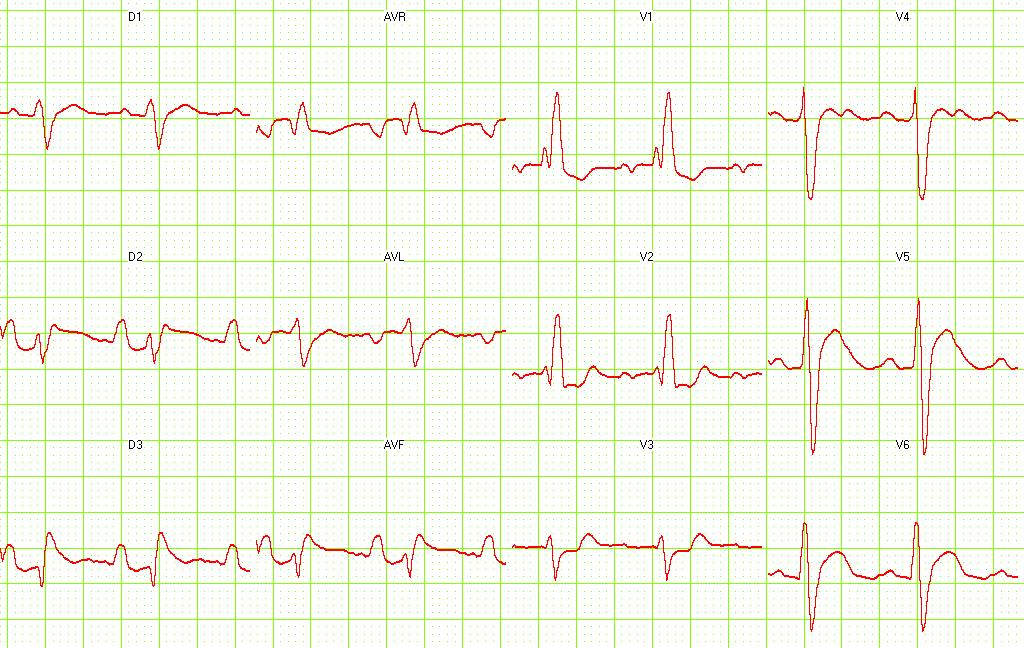
Electrocardiogram of the same patient. Of note here is ST elevation in lead V4R.
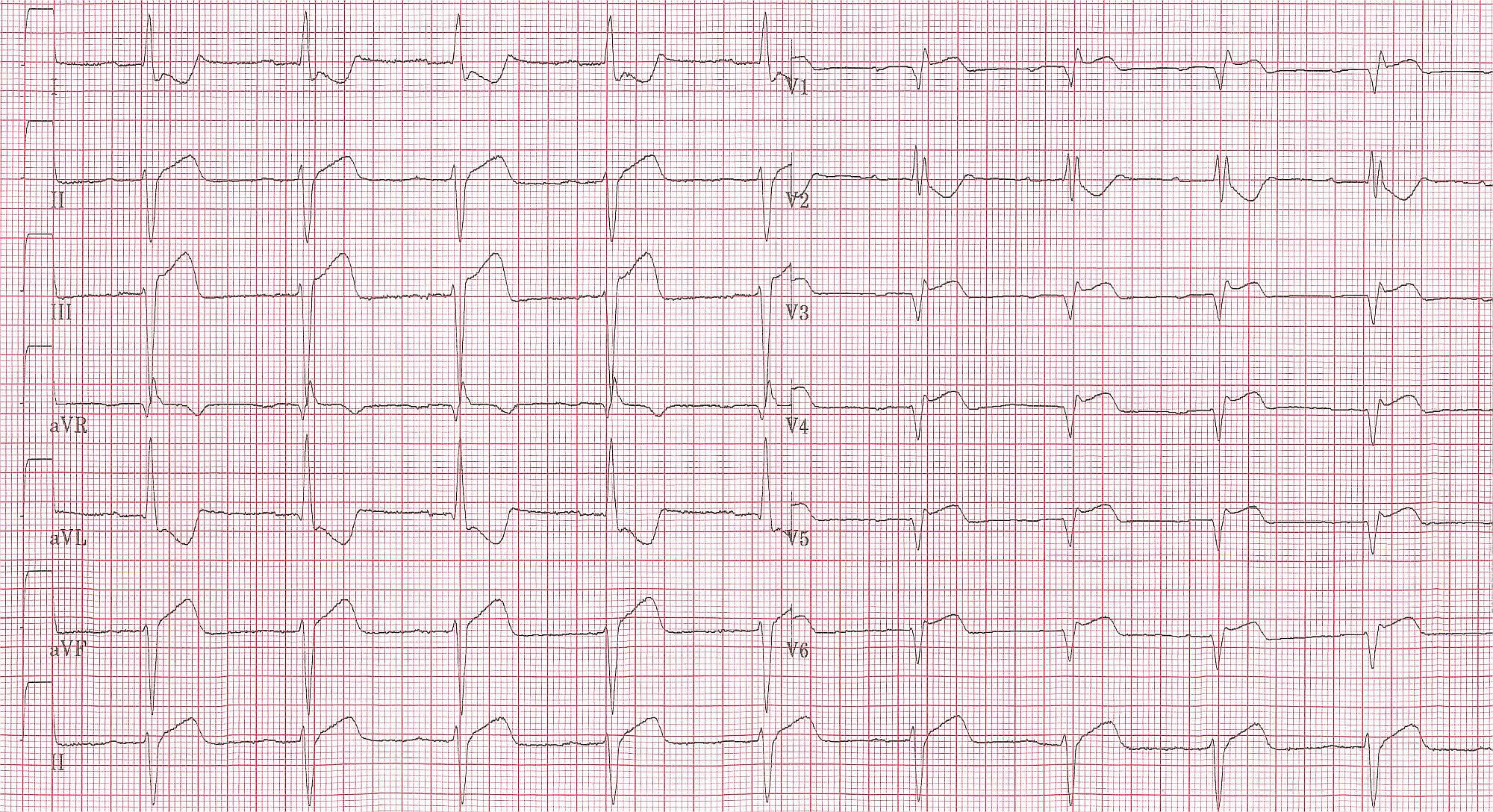
The same patient before acute MI developed. Horizontal axis shown.
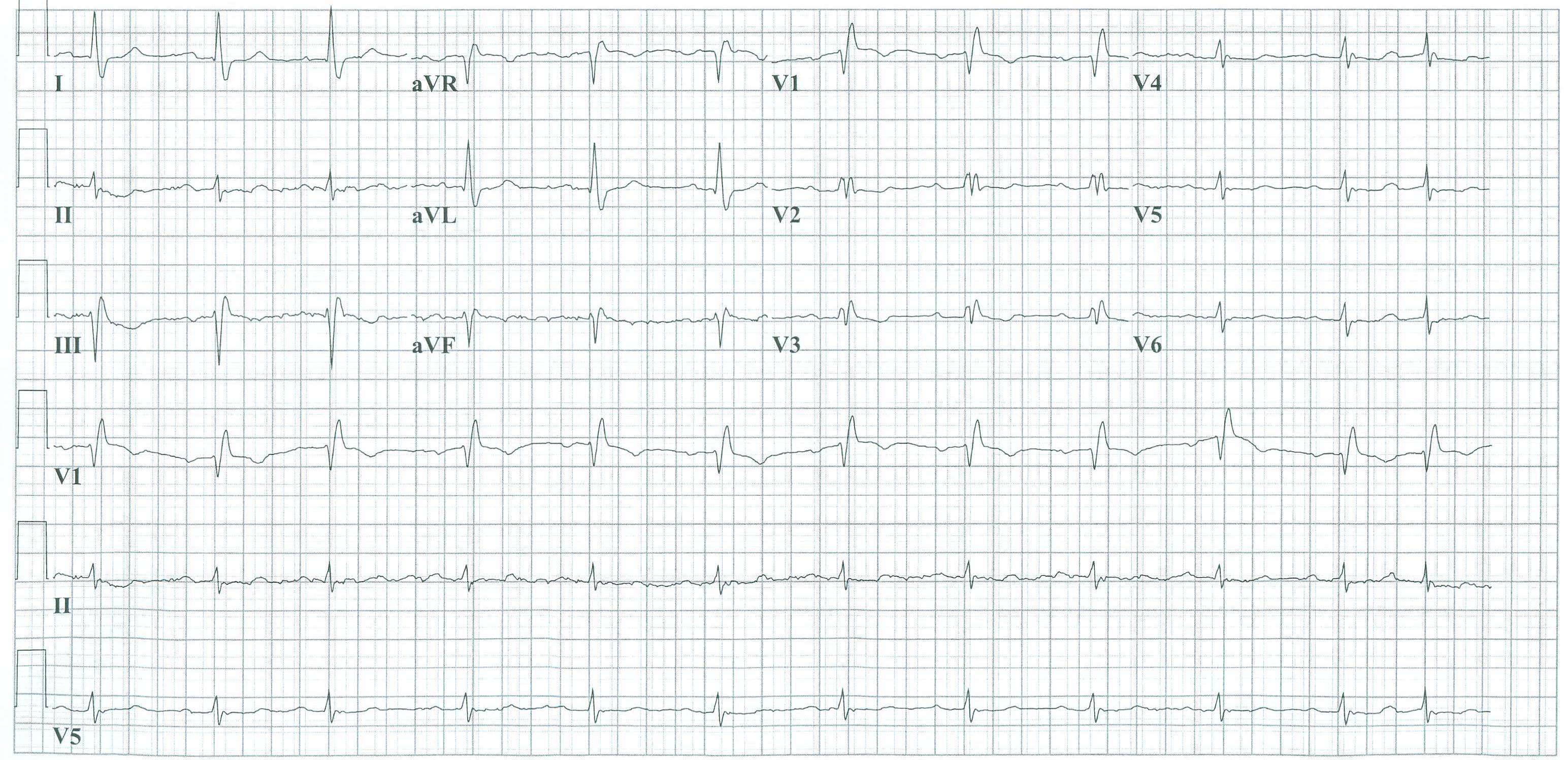
Below is an electrocardiogram of a patient with supraventricular tachycardia with RBBB.
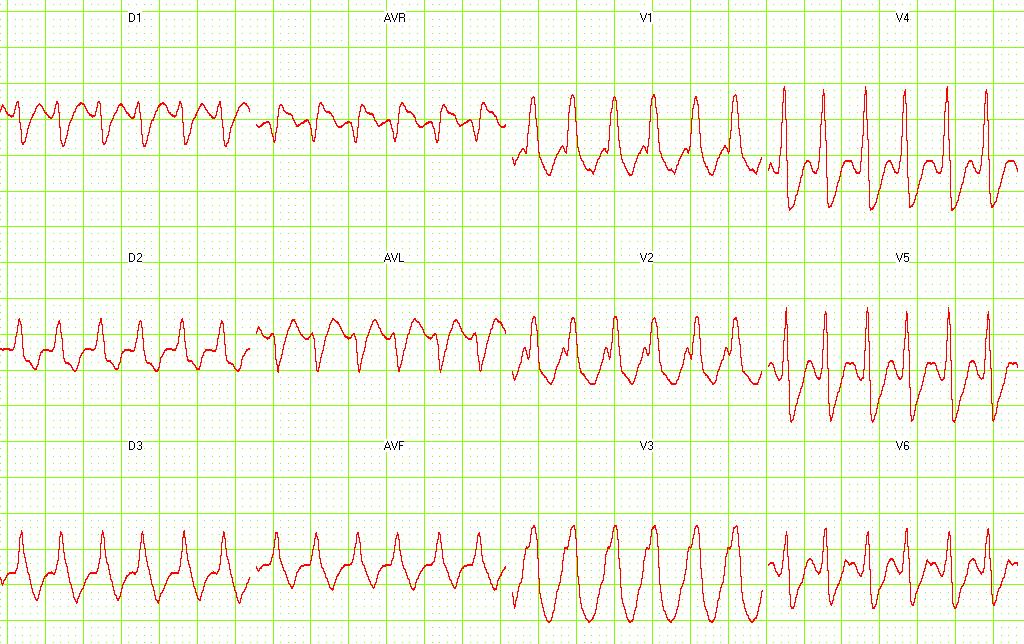
Below is an electrocardiogram of a patient with old Anterior MI with RBBB.
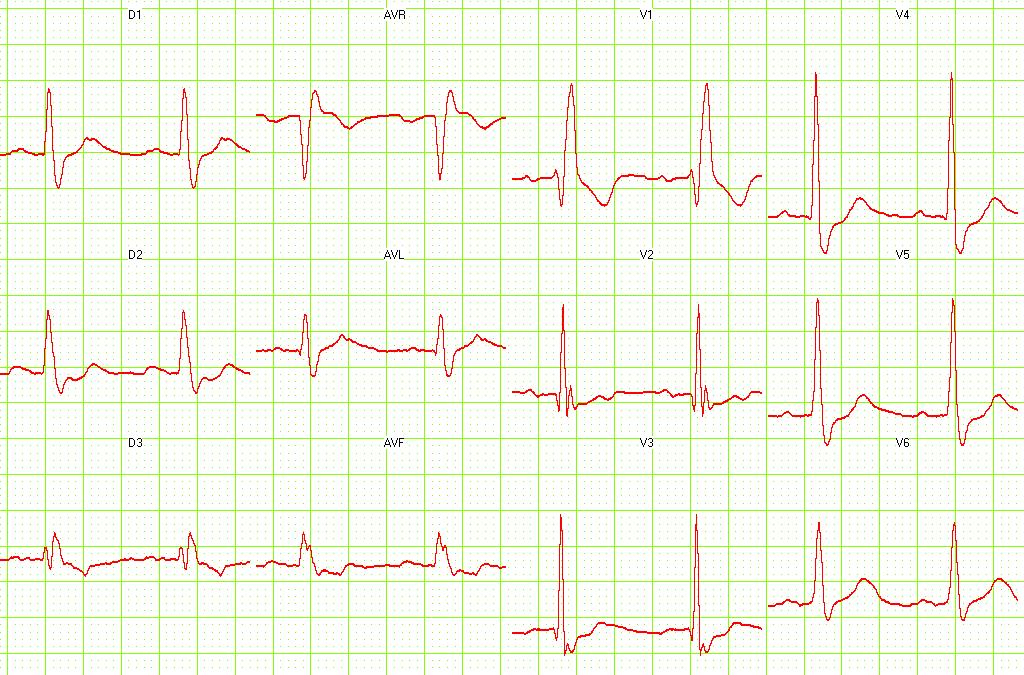
.
Below is an electrocardiogram of a patient with Old Inferior MI and Anterior MI with RBBB and LAFB.
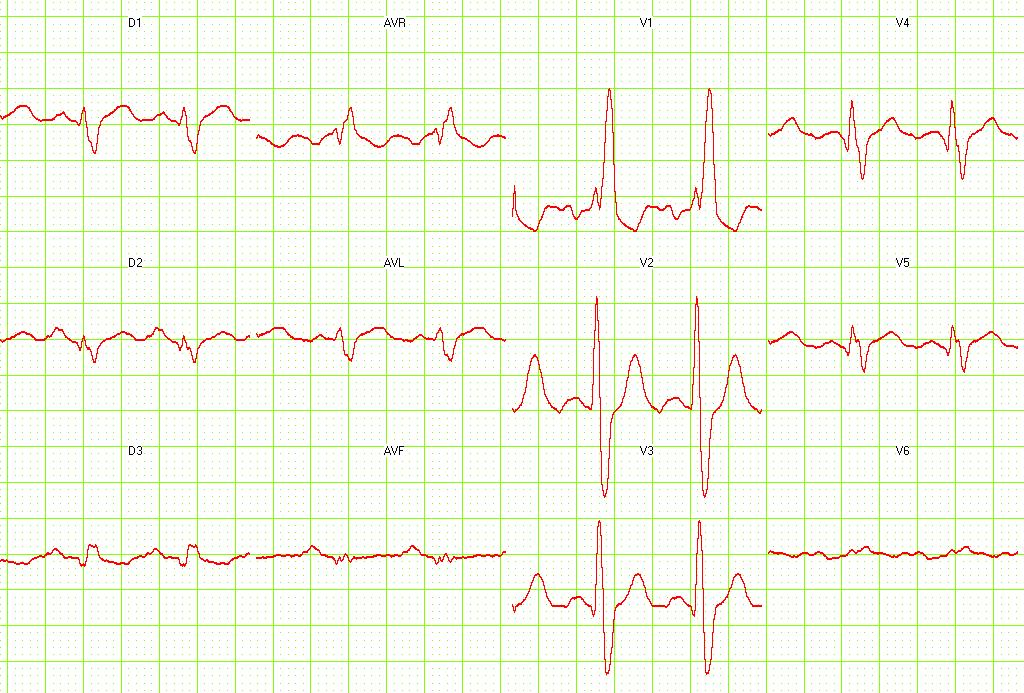
Below is an electrocardiogram of a patient with Old Inferior MI with RBBB
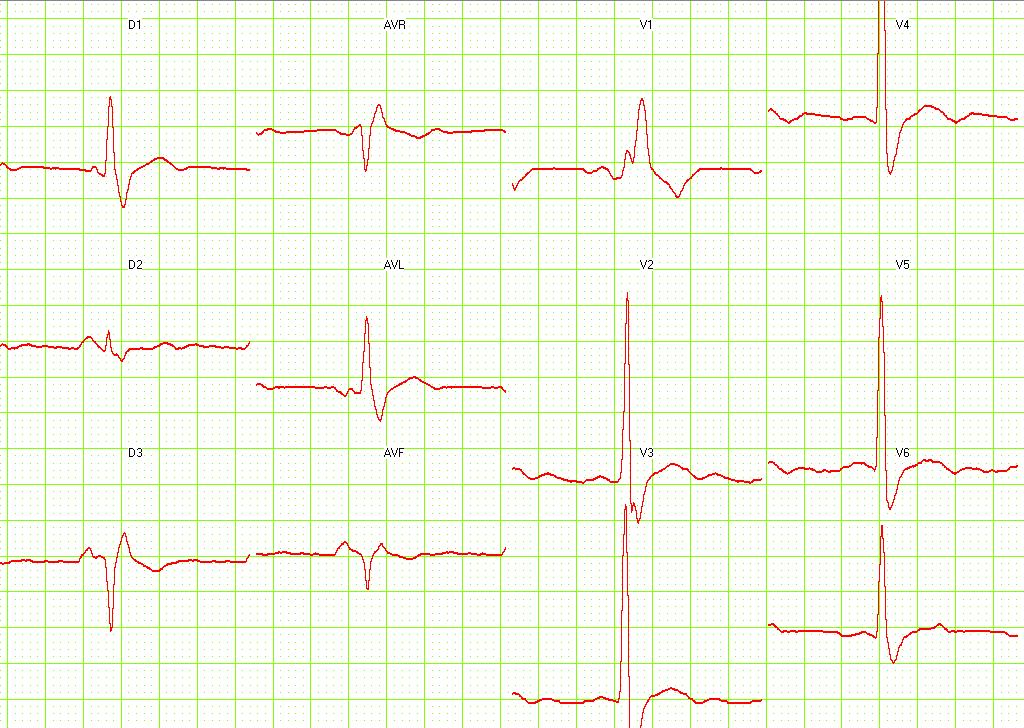
Below is an electrocardiogram of a patient with RBBB and LAFB.
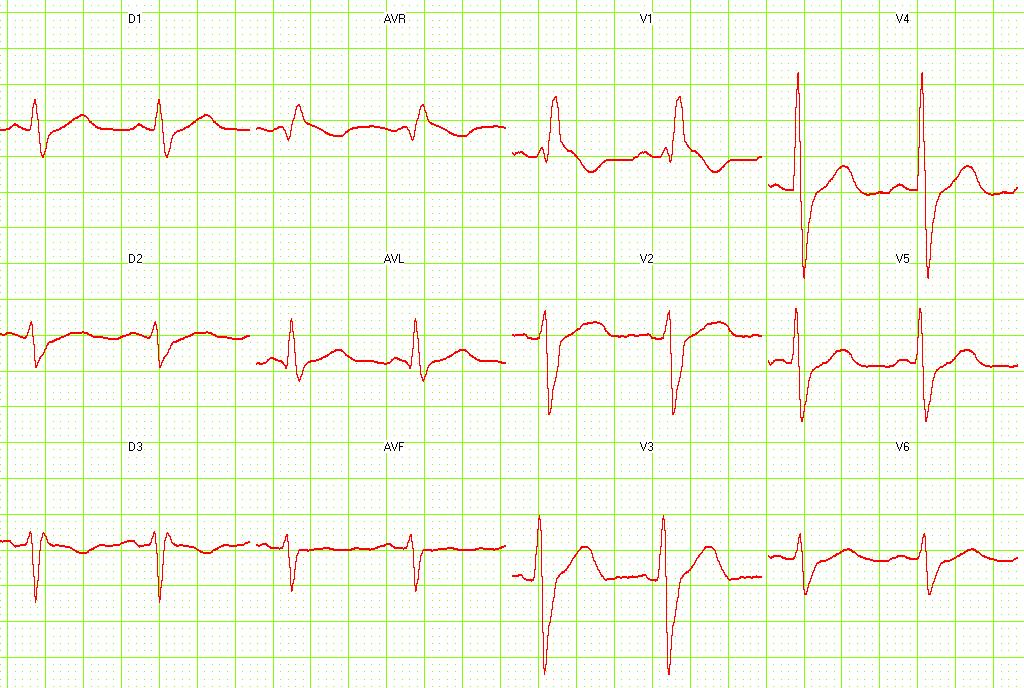
Below is an electrocardiogram of a patient with RBBB, LAFB and First Degree AV Block.
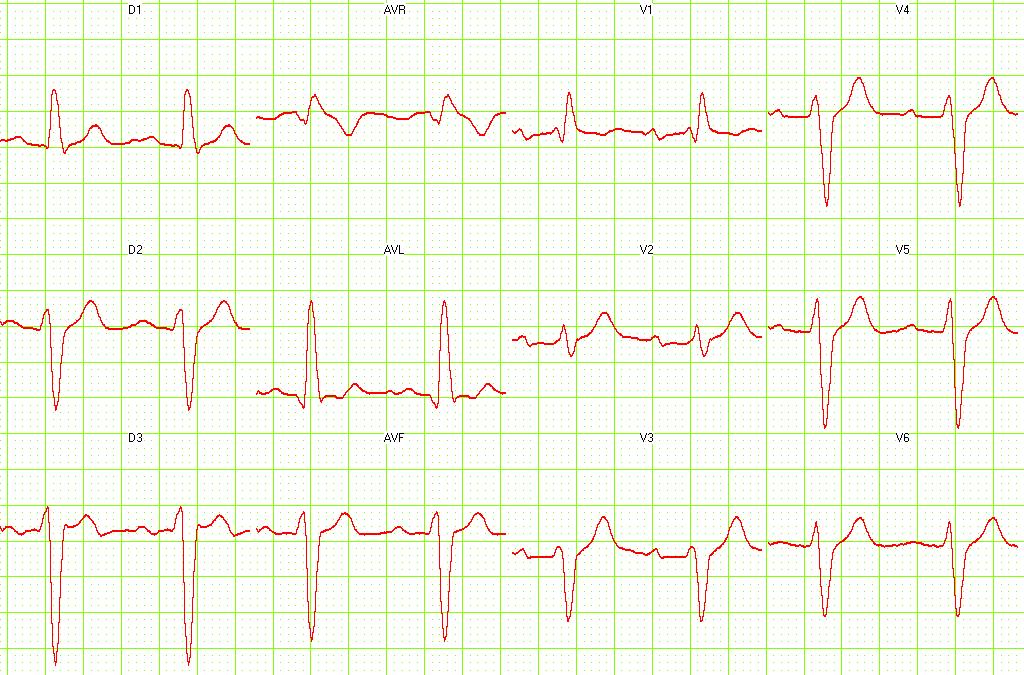
Below is an electrocardiogram of a patient with RBBB and LAFB.
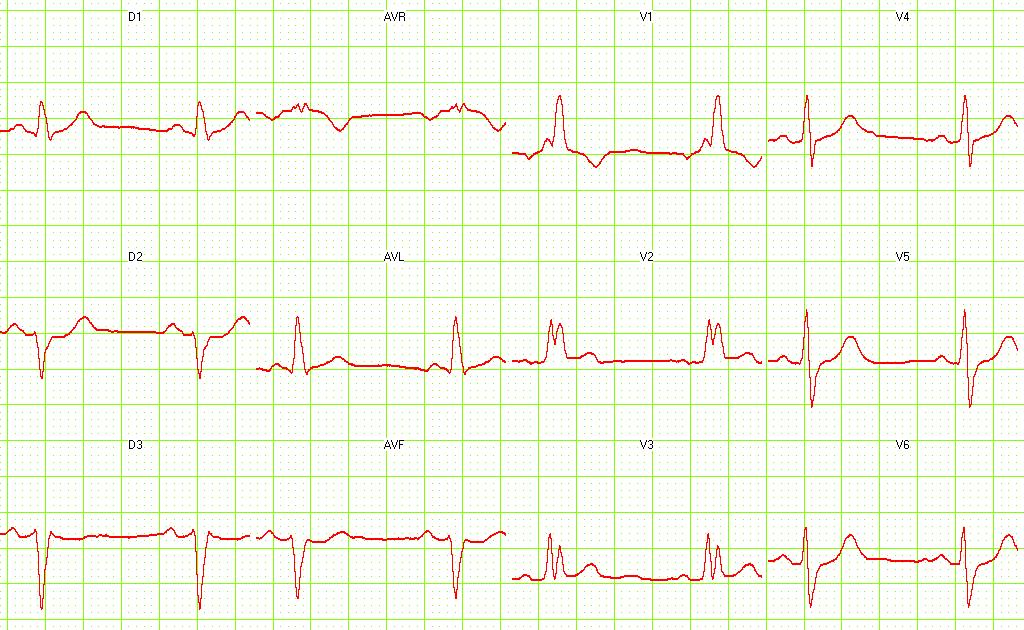
Below is an electrocardiogram of a patient with RBBB and LAFB.
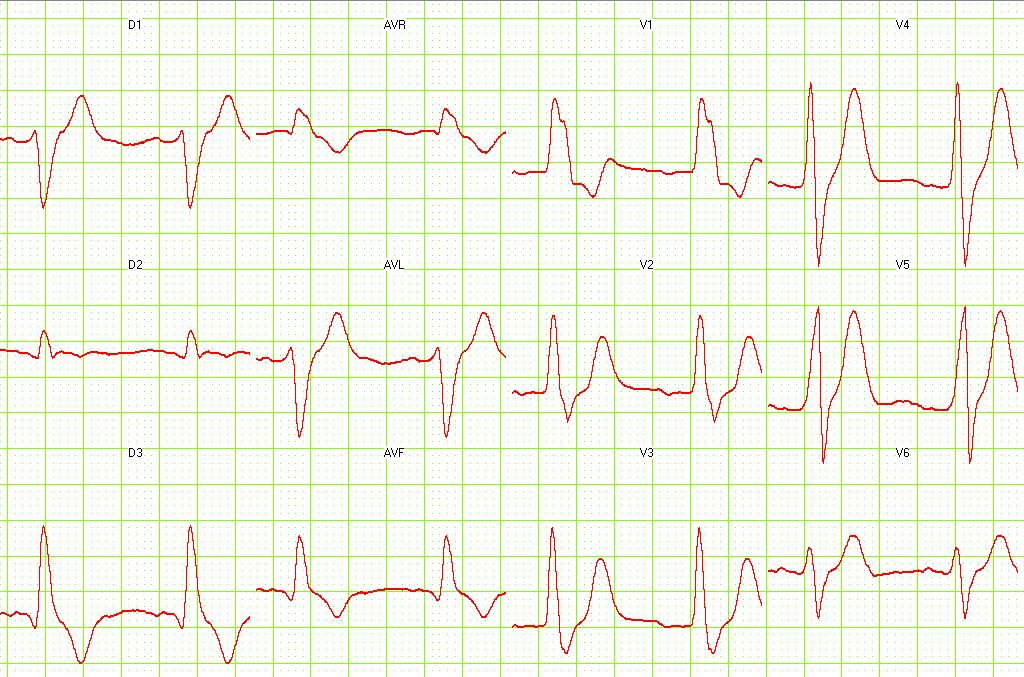
Below is an electrocardiogram of a patient with atrial fibrillation with a controlled ventricular rate. The QRS is wide (>120ms) and has a tall R' in V1 and an S wave in V6. There is a left axis deviation. The cardiogram suggests a right bundle branch block and a left anterior hemiblock. The patient has a cardiomyopathy with an ejection fraction of 20%.
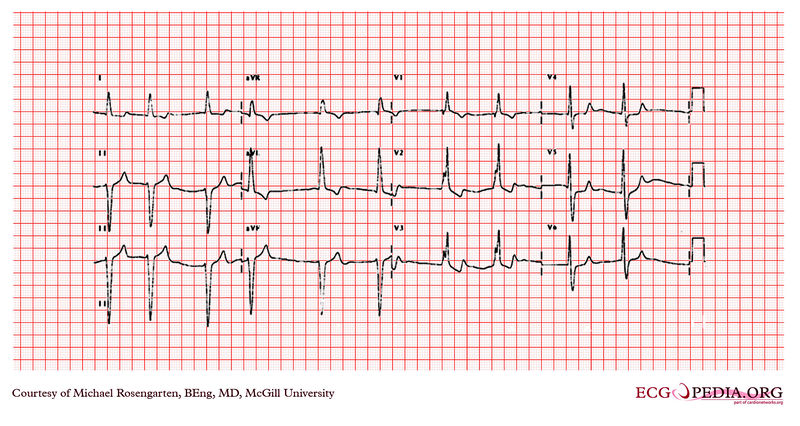
The cardiogram below shows sinus rhythm with a normal PR interval and a prolonged QRS interval (>120ms). There is a conduction abnormality best described as a right bundle branch block due to the rsR' wave in V1. Note the S wave in V6 which is due to the RBBB is smaller than the R wave in V6. The axis of the QRS is difficult to determine, but one usually looks at the first 60 ms. (1 1/2 small squares) to determine the axis with a RBBB. If the axis of the first 60 ms. of the QRS is more than 90 degrees and there is an rS in lead I and a Q in lead III then on would consider a left posterior fasicular block. This is not the case here.
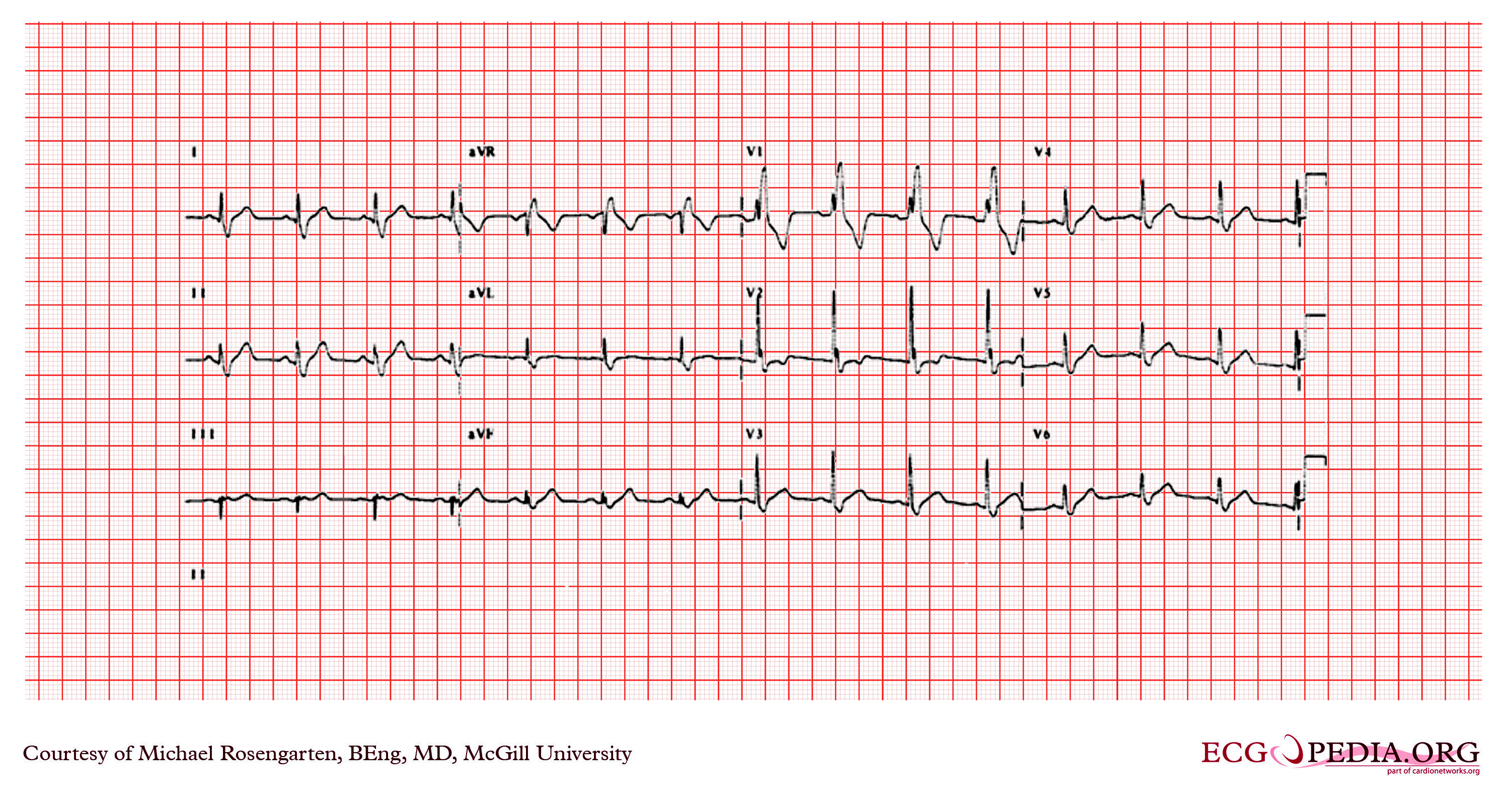
Below is an electrocardiogram of patient with RBBB
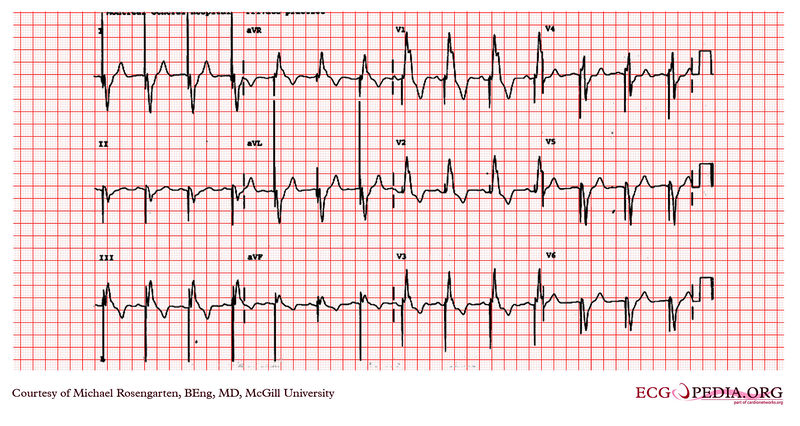
Treatment
In general treatment for right bundle branch block is not necessary. These patients need not limit their activity. However, if the RBBB progresses to heart block, the patient may be at risk for adverse clinical outcomes. In these patients further electrophysiologic testing may be necessary. Those patients who develop right bundle branch block after surgery should undergo EKG testing each year to evaluate for interval changes. In particular, care should be taken to observe for the development of sinus bradycardia supraventricular or ventricular ectopy.
Related Chapters
Sources
Copyleft images obtained courtesy of ECGpedia, http://en.ecgpedia.org/index.php?title=Special:NewFiles&offset=&limit=500